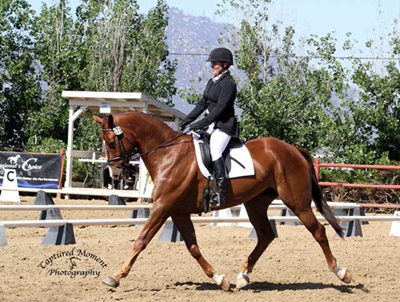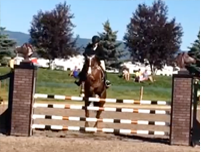|
The World of Three-Day Eventing
Eventing: The Ultimate Triathlon - A Summary
Eventing can truly be viewed as an "equestrian triathlon." It requires coordinated, athletic horsemanship both on the flat, and over all classes of obstacles. Having developed over many centuries from the comprehensive testing of the ideal military charger, today it consists of three phases: Dressage (rigourous equitation), Endurance (Cross-country aka "Steeplechase"), and finally, formal arena Show Jumping. This highly demanding sport has evolved into a dynamic and exciting sporting activity which inspires avid interest from all levels of horse enthusiast - from the weekend hobby rider up through the world's finest competing professionals, raising little doubt as to why it stands proudly today as an Olympic Event that so many fascinated onlookers look forward to every four years.
Day One (of Three): Dressage
Every eventing competition begins with the Dressage phase. Dressage ("training" in French) was originally designed to show a horse’s ability to perform precise, intricate movements during parades that displayed a formal review of military troops. Today, the dressage test demands demonstration of a prescribed series of articulated movements, all performed within an enclosed arena. The confluence of controlled precision, smoothness, modulated suppleness, and virtually intangible partnership between horse and rider come together to demonstrate the horse’s amazing abilities to respond athletically, yet obediently. For the ultimate ideal, the horse appears to perform these test movements on its own self-accord, responding in harmony to and with its partner above. These tests are scored based upon each and every movement, akin to the scoring of the requisites in gymnastics, or the compulsories in figure skating, where the overall harmony and precision of the test performance is folded into the judge's critical consideration.
Dressage plays an essential role in developing a three-day event horse, as it helps to construct the appropriate mix of muscular strength and suppleness that is needed for the other two days of competition, for which the horse must be both unbelievably fit and strong, and yet able to nearly perfectly modulate (lengthen and shorten) its critical stride while at full gallop speed. 
The ultimate purpose of the dressage test is to demonstrate a superior level of communication between horse and rider, and display the power and grace required to perform each movement with balance, rhythm, and suppleness. Due to the comprehensive demands of this sport, the three-day event horse must reach the extreme peak of physical and athletic fitness, such that only a strong and tactful rider will be found able to demonstrate the skill needed to harness and direct the amazing equine energy and stamina into an overall polished and powerful performance. Scoring is "negative" - that is, one begins with a perfect "zero," and it is so-to-speak "downhill" from there, as the judge issues demerits for each subsequent imperfection.
Day Two (of Three): Cross-Country
The incredibly demanding - yet always spectacular - cross-country test takes place on the second day of competition. The object of this test is to demonstrate the speed, endurance, and jumping ability of the horse over varied terrains and obstacles, while under the governing regulation of pace-control. To accomplish this task, both the horse and rider must be in peak condition - imperceptibly melded together in near-perfect communication. The horse must be particularly brave, yet trusting and obedient, and the rider must apply a subtle knowledge and experience of the factors that influence pace, in order to release just the right measure of the horse’s energy as and where necessary, in order finish "double clean" - having accomplished the course with no penalty errors AND within the prescribed time window - mandatory for earning the chance to finish near the front of its class.
The cross-country course covers approximately 2.75 to 4 miles, along which one encounters between 24 and 36 obstacles - both fixed and solid, wet and dry. This phase of the contest is ridden at a full gallop, with the exact speed requirements calibrated to the categorical level of competition..
Cross-country courses require both horse and rider to be bold in character, mentally sharp, and ready to have the limits of their physical stamina put to a penultimate test in order to fulfill the overall measure of each horse-rider partnership - completing the course "on time" (within the prescribed window) with the fewest possible penalties. Penalties are accrued either through jumping errors (such as if a horse "refuses" or "runs-out" when arriving at an obstacle, or if a rider falls from their horse), or additionally, by missing the specified time window - finishing too fast, or too slow.
Of the three days of competition, the cross-country phase is usually the most appealing to spectators and riders alike. It is considered the ultimate challenge to prepare a horse for this rigorous test. Unlike other sports, where only the human body and spirit are pitted against the clock, in eventing, two minds and bodies must work as one. Additionally, eventing is the only high-risk Olympic sport where men and women compete as equals - divisions are not distinguished by gender. Notably, some of the top riders in the world today are women, coming from all over the globe.
Day Three: The Finalé - Show (Stadium) Jumping
 The third and final test takes place in the formal Show Jumping Arena, where the designated course features a series of colorful fences that are usually composed of light-weight barrier rails - designed to be easily knocked down. The show ring is fully enclosed, defining a prescribed course which must be successfully negotiated (where the goal is to receive no demerit points for dropping a rail, nor for refusals, run-outs or go-arounds, while simultaneously finishing "on-time." This final phase challenges the ultimate stamina and recoverability of the horse after its having endured the prior two phases, and demonstrates that it is fit to continue work. The third and final test takes place in the formal Show Jumping Arena, where the designated course features a series of colorful fences that are usually composed of light-weight barrier rails - designed to be easily knocked down. The show ring is fully enclosed, defining a prescribed course which must be successfully negotiated (where the goal is to receive no demerit points for dropping a rail, nor for refusals, run-outs or go-arounds, while simultaneously finishing "on-time." This final phase challenges the ultimate stamina and recoverability of the horse after its having endured the prior two phases, and demonstrates that it is fit to continue work.
According to the Rulebook of the FEI (the international governing body for equestrian sports), "The test on the third day is not an ordinary show-jumping competition... its sole object is to demonstrate that, on the day after a severe test of endurance, the horses have retained the suppleness, energy and obedience necessary for them to continue in service."
The show jumping course requires very exact riding; it consists of between 12 and 15 jumping obstacles, which normally include at least one “combination" jump, at least two spread fences, and in some cases, even a ditch.
The course design and layout fully tests the horse and rider’s ability to negotiate a mixed variety of fences presenting differing heights, widths, and levels of technicality. This requires the horse to remain balanced and supple - even for tight turns and short inter-fence distances. The horse must be able to lengthen or shorten its stride in an instant. To do this, the rider must always know exactly where he or she is during the approach to any fence, while directing an extraordinarily obedient horse that will instantly respond to any applied commands. For the spectator, this sport is both exciting and breathtaking to watch, as having just one single rail knocked down can dramatically alter the final standings - especially in high-level events.
At the conclusion of competition, each of the competitor’s three scores are totaled, including their accrued penalties. This then determines the final standings, where the lowest total is always the winning score. In the case of a team competition, the individual scores of each of the team members are added together. After all team members have completed the competition, the lowest three scores prevail, from which the team with the lowest team total is pronounced the winner.
SUMMARY
The unique sport of Eventing is best described as an equestrian triathlon, with historic military ties that are meant to replicate what a horse and its rider would go through in the formal cavalry. Over a challenging 3-day period, horse and rider compete as a tight partnership in all aspects of horsemanship, working as a highly-trained team to complete three successive tests, with their cumulative 3-day performance coming together to determine their final standing.
Dressage is designed to test obedience and the fascinating, subtle, harmony between horse and rider. Cross-country is designed to test endurance, having horses run long distances, while calling for full gallop at high rates of speed. It also tests the courage, boldness, confidence, and stamina of both horse and rider. Show jumping examines precision, agility, and technique while jumping over high obstacles and turning sharply whenever the rider so commands. This is a true test of both condition and focus, coming directly after completion of the previous dressage and cross-country phases.
* Credit and cordial appreciation goes to Karen and David O'Connor for authoring descriptive materials.
|
|
